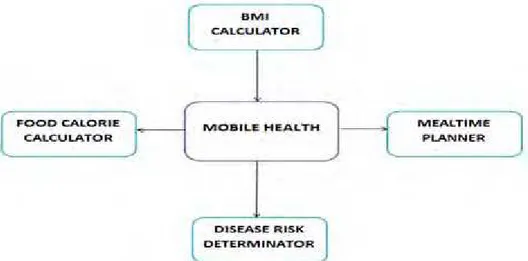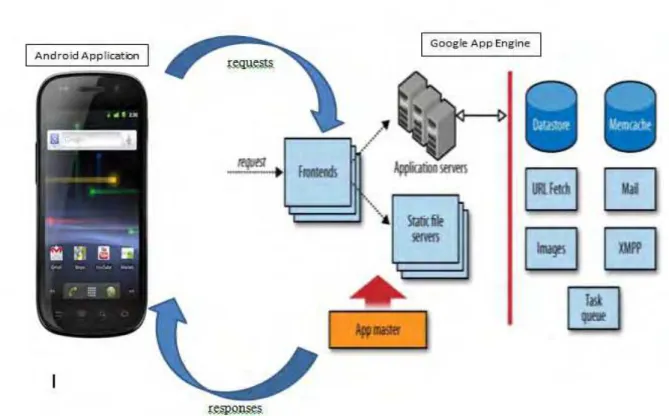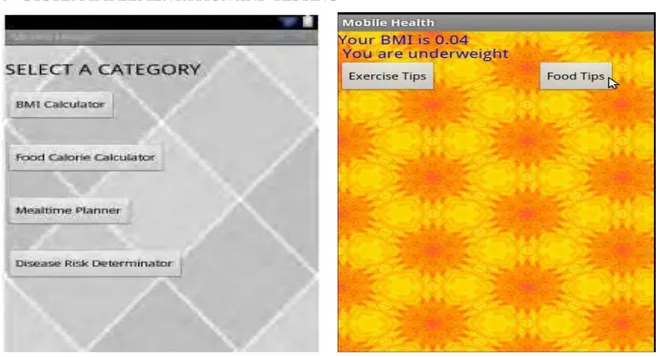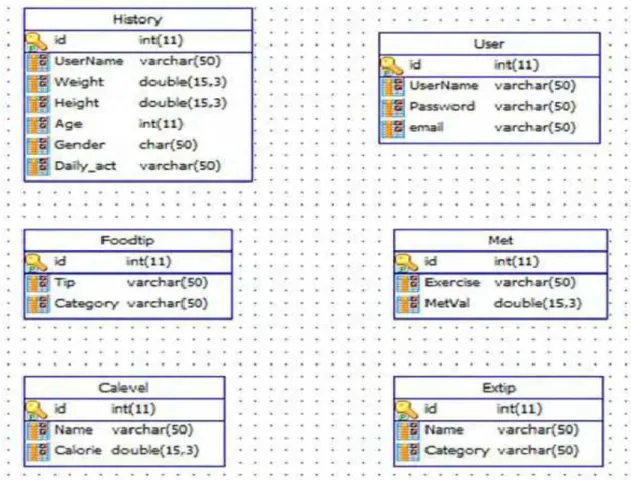DESIGN
AND
DEVELOPMENT
OF
A
PERSONAL HEALTH MONITORING
SYSTEM
ON
ANDROID
MOBILE
PLATFORM
ROBERT SOWAH
Department of Computer Engineering, University of Ghana, Legon, Accra rasowah@ug.edu.gh
JOANA NKRUMAH-BUADU
Department of Computer Engineering, University of Ghana, Legon, Accra joanabuadu@yahoo.com
SETH Y. FIAWOO
Department of Computer Engineering, University of Ghana, Legon, Accra syfiawoo@gmail.com
Abstract:
The ignorance and lack of easy access to basic health information such as Body Mass Index (BMI), standard amounts of food calorie intake and nutritional semantics on a daily basis is a problem that has been prevalent in developing countries such as Ghana for the past decade. Adverse detrimental health conditions such as diabetes, hypertension, stroke, etc. have been statistically recorded and it has been proven that these result out of poor diet and sedentariness.
A solution to this problem can be attained with the application of the principles of mobile web application development, coupled with an adequate comprehension of human biology, physiology and dietetics. Individuals are privileged to have a personal way of addressing health issues and habits, based on daily interactivity with the system. Currently, mobile phones equipped with Android Operating System (OS) and Java are widespread thus utilising existing infrastructure and resources to meet health needs.
This paper implements strategic algorithms that enable mobile devices, running on the Android (OS) to be utilized maximally for data collection and analysis via user-system interactivity. Positive results were obtained after system tests were carried out. Its impact on the healthy development of society and individuals was coherently established, buttressing how indisputable its relevance is to personal health monitoring.
Keywords: Android application, health monitoring, data processing, decision-making, online transaction processing.
1 INTRODUCTION
The rate of mobile phone usage in the world today has increased exponentially at a fast and unimaginable rate. Based on the company “The Mobile World” in 2007 [MW2007] the global mobile phone usage had exceeded 3.25 billion at the end of 2007 which is equivalent to around half of the world’s population [1]
In the past decade or so, mobile phones were merely seen and classified as portable communication tools, with the sole capability of making calls, without any physical connection to a landline. Today, certain advancements have been achieved in mobile computing industry through the inclusion of GPS systems, accelerometers, and even touch screens. Different kinds of mobile operating systems have been introduced in response to the goal of designing increasingly powerful software to take advantage of the number of processors packaged in computing hardware. Some of these operating systems are the Symbian OS, the Apple iOS Windows Mobile and Android. Due to the advanced nature of computer architectures for embedded systems computing, mobile computing has become well integrated into the very fabric of our modern way of living. It is a very useful tool for personal health monitoring and many devices such as iPhone, iPad, Google Nexus and other mobile computing devices have applications developed for health monitoring and targets specific needs of individuals. Our developed application which runs on the android platform is customizable and user friendly and adaptable to the Ghanaian experience.
the research work. Section 2 presents the literature review addressing the various health monitoring systems on mobile devices. It identifies the strengths and weaknesses of such systems and proposes a novel method for personal health monitoring using the android operating systems. It highlights the choice and significance of the Android OS for designing personal health monitoring systems. Section 3 provides the novelty of the system design architecture and methodology including the concepts, algorithms and flowchart. It highlights the various modules with their design and procedures for implementation. Section 4 focuses on the actual hardware and software implementations and corresponding integration. Section 5 details the testing and performance evaluation of the proposed health monitoring system. Finally, Section 6 provides the conclusion on the design, which is based on performance testing. Relevant recommendations for future enhancements are suggested. 2 PROBLEM DEFINITION
Personal health monitoring by individuals is a key component for staying health and reducing the number of premature deaths due to certain health conditions aggravated by poor healthy lifestyles. Such monitoring mechanisms act as prognosis for certain diseases. Tracking of daily living activities such as exercise regimen and food intake on a mobile device could provide substantial amount of data that could be used for proper diagnosis of certain ailments in the case of eventualities.
There have been important advances in recent years regarding our understanding of the link between health and economic development in low-income countries.
The Commission on Macroeconomics and Health made a strong economic case for investing in health in their final report published in 2001. Although confined primarily to evidence from low- and middle-income countries, it helped bring about a shift in the prevailing paradigm: health was no longer seen as a mere by-product of economic development, but as one of several key determinants of economic development and poverty reduction. This has helped pave the way for health to be included in national development strategies and policy frameworks in poor countries [1].
To make this transition and imbibe this paradigm shift, it is important that developing countries with increasing trend of building telecommunications infrastructure harness fully the potential of integrating mobile computing as a key component of their health policies.
The ignorance of the health status of an individual on a daily basis is a problem that currently exists in today’s society. This can be blamed on lack of awareness as well as difficulties encountered in the accessibility of basic personal health information, such as body mass index, amount of daily food calorie consumption, nutritional facts, and nutritional semantics. The problem has led to the existence of devastating health problems, retardation in national economic growth and development, time wastage leading to low labour outputs for goods and services, and unnecessary pressure on health professionals.
Since mobile phones penetration is high compared to landline usage in developing countries, it is important that efforts be made in using this avenue for driving government policy for a healthy and strong workforce which eventually leads to productivity and sustained economic growth. The economic growth and development infrastructure of a nation is a process that can only be manipulated by the healthy state of its individuals. When an individual is unhealthy, it does not only affect him or her alone, but also the nation as a whole. An indisposed individual is usually prone to being inefficient in the job environment, resulting in undesired productivity levels. Furthermore, it is very disheartening when people take leave off their busy schedules in the offices or elsewhere just to meet up with a health professional for a minor check-up in the hospital. Time is wasted and doctors are unnecessarily burdened even though they need to attend to more complicated cases. Most people in Ghana eat any how and go to the extent of abusing the intake of certain food nutrients. They do not have any inkling about how to keep the daily consumption of those nutrients on a standard scale of required amounts. The prevalence of different kinds of ailments can be accounted for due to this problem.
Therefore in order to curb this menace created by ignorance about health issues, poor eating and unhealthy lifestyle of the populace, we propose a system that will help address these issues on the android mobile computing platform that provides an individual the tool for effective health monitoring, tracking of daily food requirements and generation of health tips so as not to suffer from some of the noted drastic health problems. 3 LITERATURE REVIEW ON ANDROID APPLICATIONS FOR HEALTH MONITORING
computing servers. It has faced some legal challenges from patients and others in the health care delivery sector. The individual’s health status is rated on a scale of 1 to 10. The data is then time-stamped, uploaded to a server and a timeline of the patient’s wellness is generated. A time graph of his or her health status over time is then made available and displayed. A Java server connects the android application to the services it needs in order to achieve the desired functionality of the project. The server administrator retains the capacity to control and secure the server, as well as maintaining data and connection integrity, (2) BeWell is an application developed by the researchers in [Lane et al] that assists users in maintaining a healthy lifestyle by keeping track of their everyday activities such as sleep, physical activity and social interactions. It does not end there, but makes available excellent feedback to enhance user health, thus, helping an individual to easily identify any signs of decline, (3) the authors in [Hicks et al., (2010)] developed AndWellness, which is a health application on an android platform. The application works by collecting data via an Android device, stores the data on a server that performs configuration and goes further to display the statistical breakdown of participants. Users are made to provide answers to surveys at certain configured intervals. The answers to the surveys are uploaded onto a central server via a wireless mechanism and parsed into a central database which can be seen by the participants or even researchers. The server for the AndWellness application is implemented in Java 1.6 and is hosted in the Apache Tomcat 6.0 environment. Data storage is made possible through the help of MySQL Database, (4) Woudshet, a researcher from University of California developed the Android Electrocardiogram (ECG) Application in [Woudshet, (2012)]. It helps in monitoring electric activities of the heart in a cheap, efficient and easy to use manner from the users’ mobile phone. The application can be used during exercises so as to monitor one’s heart conditions. These features make it suitable for a fitness and healthcare solution, (5) Diabetes Care developed by Anders Widén in [Widén, (2008)] for Android is implemented as an android application with the database residing solely on SQLite. It is designed to help diabetic patients monitor their health.
In [Arshad et al.]. Arshad et al. reported their research experience in using mobile computing middleware in context of health-care through provision of a novel framework for incorporating mobile computing devices in different settings. Research findings obtained indicated that since clinicians and patients are very mobile, mobile computing must be fully exploited to achieve desired goals in health care delivery and monitoring.
Based on these reviewed literature, certain strengths and weaknesses are brought to the fore, essentially all deal with patients’ care in hospitals only, with the various treatment options. Our proposed system principally focusses on prevention rather than cure by ensuring individuals monitor their health and take proactive measures to ensure healthy lifestyle and increased productivity.
The health monitoring system is customizable based on individual preferences for certain Ghanaian dishes. The database contains some known Ghanaian dishes and their corresponding calorific values.
The uniqueness of the proposed system is the development of different modules and integrating them while allowing for the ease of customizability for different persons based on lifestyle and work environments. It involves the creation of a database of indigenous Ghanaian foods and corresponding calorific values obtained from Department of Food and Nutrition, University of Ghana, Legon. This integrated platform synergistically warrants the need for extensive programming skills in databases, android programming and mobile computing. 4 PROPOSED SYSTEM DESIGN AND METHODOLOGY
4.1 System Architecture
The following architectural diagram shows the different modules that make up the Mobile Health android application.
The proposed android architectural framework and module development as presented above encompasses four (4) modules namely: (1) Food calorie Intake Calculator (2) Mealtime Planner (3) BMI Calculator and (4) Disease Risk Determinator.
(1)Food calorie intake Calculator Module
This module computes the calorific content values for the user interactive menu choice for breakfast, lunch and dinner. This module computes the customized menu choice and offers suggestions for other menu options to achieve your goal of either losing weight or eating healthy foods.
(2)BMI Calculator module
This module calculates the Body Mass Index (BMI) for a person based on the height and weight of the person using the formula:
2Weight kg
BMI
Height m
(1)The essence of this module is to generate useful information regarding the BMI parameter used for ascertaining a person’s risk of heart disease, diabetes etc. The BMI is a heuristic proxy for estimating human body fat based on an individual's weight and height.
(3)Disease Risk Determinator Module
Based on the computation of the BMI, and the user specification of the nature of work, exercise routine and other factors, the Disease Risk Determinator module then determines your risk profile and tracks it while offering excellent Meal time Planner to get back into shape and avoid unnecessary hospital visits due too poor healthy lifestyle.
(4)Mealtime Planner Module
This module presents to the user the various meal plans for breakfast, lunch, and dinner based on the amount of calories needed by the person taking into consideration, age, type and nature of work, several favourite Ghanaian dishes for breakfast, lunch and dinner.
4.2 System Components
4.2.1 Web Application
The system enables information access via the web. The web application resides and runs on The Google App engine infrastructure.
4.2.2 Database Server
This component hosts the database which would store information related to the various Ghanaian dishes that are made available to the developers based on extensive research conducted by the Department of Food and Nutrition of the University of Ghana. The data is hosted in a MySQL database and accessed by the Android application.
4.2.3 Web Service
The web service is made available to enhance faster and more reliable information exchanges between the android application and the database.
4.2.4 Android Application
The Android application which makes it possible for a user to plan meals, track daily food requirements and generate useful help tips for the user.
4.3 Business Logic
Figure 6: Flow Diagram of the system (3)
5 SYSTEM IMPLEMENTATION AND TESTING
Figure 8 :System database as designed and implemented in MicroOlap software
6 CONCLUSION AND RECOMMENDATION
This paper presented necessary guidance and health recommendations for mobile users who have installed the android applications. The proposed system model generates food tips and recommendations for different categories of people who are underweight, overweight or obese due to a computation of their body mass indices. It specifies certain exercise regimen types that are appropriate for these different kinds of people. Further expansion to allow for versatility and ubiquity is to implement the Personal Health Monitor app on other mobile platforms apart from android. This project was designed to run on android because of its fast penetration into the market currently, as well as its open source development.
Acknowledgements
The authors would like to acknowledge the technical and nurturing environment provided by the Department of Computer Engineering, University of Ghana. The grant award from the Carnegie Corporation of New York for supporting the University of Ghana Next Generation Academics in Africa Project in organizing the Write Shop Program held at Koforidua, Ghana from December 11-16, 2012 is also hereby acknowledged.
Finally, the authors would like to thank Dr. Godfrey Mills for providing several helpful suggestions on an earlier draft of this paper.
References
[1] Anbalahan S., (2007): Common mistakes in two-tier applications . Plynt Publication, http://www.palizine.plynt.com [date accessed: 23/05/12].
[2] Arshad U., et al.: Exploiting Mobile Computing in Health Care. Department of Computer Science, University College London. Webpage: www.cl.cam.ac.uk/~cm542/papers/iwsawc.pdf [date accessed : Dec 12, 2012 ]
[3] bmi-calculator.net, [online source] from http://www.bmi-calculator.net/, [date accessed: 23/05/12] [4] Calculator.net, [online source] from http://www.calculator.net,[date accessed: 23/05/12].
[5] Hicks J., et al. (2010): AndWellness: An Open Mobile System for Activity and Experience Sampling. UCLA CSD, UCLA Stats, San Diego, USA.
[6] Holmes A.T. (2011):The fitness Corner Blog. (January 27,) Webpage http://www. doctorholmes.wordpress.com [date accessed: 23/05/12].
[7] Jantscher M.; Talhaoui M.; De Vos D.; Cunha I.; Roszcyk A.; Datsyuk M. (2009): Android. FH Joanneum, Artesis Hogeschool Antwerpen, Haute École Provinciale de Mons-Borinage-Centre, Escola Superior de Comunicação Social, Wyzsca Szkola Informatyki, Central Ostrobothnia, Android Team 2009.
[8] Lane D. N., et al. : BeWell: A Smartphone Application to Monitor, Model and Promote Wellbeing. Computer Science Department Dartmouth College, Dartmouth Medical School, Dartmouth Institute for Health Policy and Clinical Practice, IT University of Copenhagen. www.cs.dartmouth.edu/~campbell/papers/bewell_pervhealth.pdf [date accessed: August 2, 2011]
[9] McArdle, W. D; Katch, F.I; Katch, V. L; (2001): Exercise Physiology, 5th Ed. Lippincott Williams & Wilkins. [10] Meier, R. (2009): Professional Android Application Development. Wiley Publishing, Inc., United States of America. [11] Morillo K., et al. (2010): Personal Health Assistant.
[12] Nti I. K (2008): Introduction to Software engineering. Computer Engineering Department Lecture Material, University of Ghana, p 8. [13] Palaniswamy G.: Two-Tier and Three-Tier Architecture with example. Webpage http://www.c-sharpcorner.com/uploadfile/go [date
accessed : September 28, 2010]
[14] Sanderson D. (2010): Programming Google App Engine, 1st Ed. O’Reilly Media, Inc., United States of America. [15] Severance C. (2009): Using Google App Engine. 1st Ed, O’Reilly Media, Inc., United States of America. [16] Speckmann B., (2008): The Android Mobile Platform. Eastern Michigan University, MSc.,Ypsilanti, Michigan. [17] Thaicoding.net, [online source] from http://www.thaicoding.net,[date accessed: 23/05/12].
[18] Widén A. (2010): Diabetes care on smart phones running the Android platform. MSc. Thesis, Chalmers University of Technology, Gőtenborg, Sweden.
[19] Wikipedia.org: The Waterfall Model. Webpage http://www.en.wikipedia.org/wiki/Waterfall_model [date accessed : May 23, 2012] [20] Woubshet B. (2012): Android ECG Application Development. OULU University of Applied Sciences, BSc.



